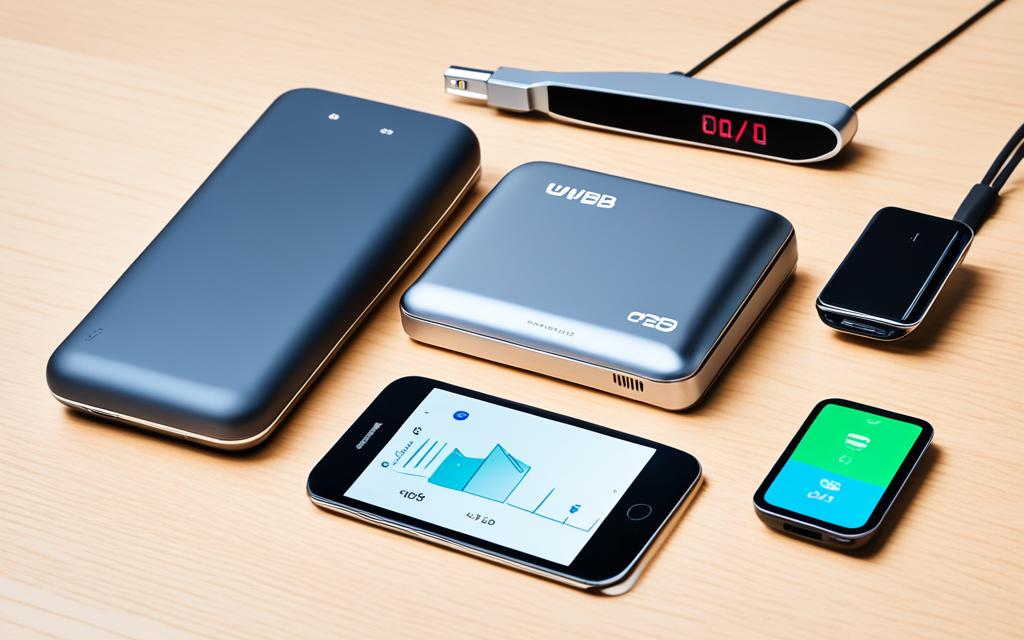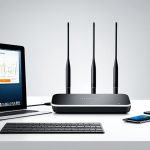Welcome to our in-depth exploration of Ultra-Wideband (UWB) networks, a wireless protocol that combines precision tracking and high-speed data transfer capabilities. As the demand for seamless connectivity and accurate location tracking continues to grow, UWB technology has emerged as a powerful solution. With its ability to provide highly precise location tracking and reliable communication, UWB is revolutionizing industries and applications that rely on precision and speed.
Unlike traditional wireless technologies, UWB operates within a wide bandwidth of 500MHz or more, allowing for low transmit power and reduced interference with narrowband wireless systems. Although its data rates may not match those of Wi-Fi, with speeds of up to 1Gbps, UWB outperforms other wireless technologies like Bluetooth and NFC. Its unique feature is its ability to provide highly precise location tracking and communication with other devices, even when not in direct line of sight.
UWB technology achieves precision tracking using short pulses of radio waves to triangulate the position and movement of objects. By calculating the time it takes for the pulses to travel between devices, UWB can accurately determine the distance between them. This makes it an ideal choice for applications such as indoor positioning, tagging, and digital keys, where ranging accuracy is crucial.
We will delve further into the workings of UWB technology, its development, and its use cases in the upcoming sections of this article. Stay tuned to discover how UWB technology is poised to transform various industries and unlock new possibilities in data transfer and precision tracking.
How does UWB work?
UWB technology, also known as Ultra-Wideband, operates by utilizing short pulses of radio waves to pinpoint the position and movement of an object. These pulses are transmitted from one UWB device and received by another, allowing for the calculation of the time it takes for the pulses to travel between the two devices, known as Time of Flight. By measuring this time, the distance between the devices can be accurately determined, enabling precise location tracking.
In addition to Time of Flight, UWB technology incorporates other techniques such as angle of arrival and time difference of arrival, further enhancing the accuracy of location tracking. These methods enable UWB devices to communicate with each other and determine their relative positions, making ranging a crucial aspect of UWB technology.
Ranging functionality is essential for various applications that rely on UWB technology. For example, in indoor positioning systems, UWB enables accurate tracking of objects and individuals within a confined space. UWB is also widely used in applications such as tagging and digital keys, where the precise determination of location is critical.
Overall, UWB technology utilizes short pulses of radio waves, along with ranging techniques, to achieve highly accurate location tracking. This capability opens up a wide range of possibilities for industries and applications that require precise positioning and movement data.
Development of UWB
Exploring the History, Regulations, and Standards that Shaped UWB Technology
Ultra-Wideband (UWB) technology has a rich history rooted in the pioneering work of renowned scientists like Heinrich Hertz and Guglielmo Marconi. However, its journey towards commercialization faced significant hurdles due to concerns about potential interference with existing wireless technologies. The Federal Communications Commission (FCC), a regulatory authority, played a crucial role in shaping the development of UWB by imposing strict regulations to mitigate such interference.
Over the past two decades, the FCC has gradually opened doors for the commercial development of UWB technology, leading to its growth in various industries. This shift in regulatory focus has paved the way for the advancement and widespread adoption of UWB.
Furthermore, the development of industry standards has played a crucial role in shaping UWB technology. The Institute of Electrical and Electronics Engineers (IEEE) introduced the IEEE 802.15.4z standard, specifically tailored for UWB, which further enhanced the accuracy of ranging and introduced advanced security features. This standardization has fostered interoperability and ensured consistent performance across UWB-enabled devices.
To promote the expansion and adoption of UWB technology, organizations such as the UWB Alliance and the FiRa Consortium have been established. These alliances advocate for the relaxation of regulatory restrictions and work towards fostering collaboration among stakeholders to unlock the full potential of UWB technology.
Take a closer look at the milestones that shaped the development of UWB:
| Year | Development |
|---|---|
| 1886 | Heinrich Hertz performs experiments with radio waves, laying the foundation for UWB technology. |
| 1895 | Guglielmo Marconi successfully sends radio signals over long distances, further advancing wireless communication technology. |
| 2002 | The FCC begins allowing limited commercial use of UWB technology. |
| 2019 | The IEEE establishes the IEEE 802.15.4z standard, optimizing UWB performance and security. |
| 2020 | The UWB Alliance and the FiRa Consortium are formed, advocating for UWB technology and its growth. |
Commercial rush for UWB
UWB technology has gained significant traction in the market, with major companies like Apple and Samsung leading the way in its adoption. These industry giants have recognized the potential of UWB and have incorporated it into their latest smartphone models, revolutionizing the capabilities of their devices.
In addition to Apple and Samsung, other prominent smartphone manufacturers such as Google, Xiaomi, and Oppo have also released UWB-enabled devices. This commercial rush reflects the growing demand for UWB technology and its ability to enhance user experiences in various applications.
The integration of UWB technology in smartphones is just the beginning. The commercial adoption of UWB is driving the development of a wide range of consumer-focused devices and applications. This includes smart locks, wearables, and home automation systems that leverage the precision tracking capabilities of UWB.
One notable industry where UWB is making a significant impact is the automotive sector. UWB-enabled devices are being utilized for secure digital keys, ensuring enhanced security and convenience for vehicle owners. This advancement in keyless entry systems showcases the versatility and potential of UWB technology beyond just smartphones.
The adoption of UWB is also expected to grow in the Internet of Things (IoT) sector. UWB’s precise tracking capabilities can greatly enhance home automation systems, enabling seamless integration with other smart devices. This seamless compatibility with existing wireless technologies like GNSS, Wi-Fi, Bluetooth, NFC, and RFID further expands the possibilities of UWB.
Examples of UWB Adoption in Leading Brands:
| Brand | UWB-Enabled Devices |
|---|---|
| Apple | iPhone 11 and 12 series |
| Samsung | Galaxy Note20 Ultra and Galaxy S21 Ultra |
| Pixel 6 and Pixel 6 Pro | |
| Xiaomi | Mi 11 Ultra |
| Oppo | Find X3 Pro |

These examples demonstrate the wide adoption of UWB technology by leading brands in the smartphone industry. As more companies recognize the benefits of UWB, we can anticipate further innovations and advancements in this field.
UWB in the media
Ultra-Wideband (UWB) technology has garnered significant attention in the media due to its wide range of use cases in various applications. One notable example is its implementation in the high-profile event, the 2022 FIFA World Cup. UWB was utilized to track the position of the ball in real-time, providing accurate data for referees and enhancing the overall viewing experience for fans.
Another critical application of UWB is in contact tracing and social distancing efforts. The high precision of UWB enables efficient tracking of individuals and objects, making it an invaluable tool in challenging environments. By utilizing UWB technology, contact tracing efforts can be significantly improved, leading to enhanced disease control and prevention.
However, as with any technology that involves tracking, privacy and security concerns arise. While UWB’s ability to track devices effectively can be advantageous, it is crucial to address these concerns to ensure responsible and ethical use. Striking a balance between leveraging the capabilities of UWB for public health purposes and protecting individuals’ privacy is essential.
“UWB technology revolutionizes the way we track and monitor, but it is essential to respect individuals’ privacy while utilizing its powerful capabilities.” – Expert in Privacy and Security
Efforts are being made to mitigate privacy and security risks associated with UWB use. Implementing robust encryption mechanisms and stringent data protection protocols can help safeguard sensitive information. Additionally, strict regulations and guidelines are necessary to ensure responsible deployment and maintain public trust in UWB technology.
Overall, UWB’s versatility and precision tracking capabilities have garnered media attention for their potential in various applications. By addressing privacy and security concerns, UWB can continue to make a positive impact in improving public health, sports events, and other industries.
UWB Use Cases
| Application | Use Case |
|---|---|
| Healthcare | Accurate contact tracing in hospitals and healthcare facilities |
| Retail | Precise indoor navigation for shoppers and location-based marketing |
| Logistics | Real-time inventory tracking and efficient supply chain management |
| Smart Homes | Automated control of lighting, temperature, and other home devices |
| Automotive | Secure keyless entry and vehicle tracking |
| Sports | Enhanced tracking and performance analysis in sports events |
UWB use cases
UWB technology is revolutionizing various industries and applications, showcasing its versatility and potential. From enhancing industry and logistics operations to transforming the concept of smart homes, UWB is opening up a world of possibilities.
Industry and Logistics
One of the key applications of UWB is in industry and logistics, where it enables accurate tracking of assets. With UWB, businesses can optimize their supply chain management by precisely locating and monitoring inventory, vehicles, and equipment. This enhances efficiency, reduces costs, and improves overall productivity.
Keyless Entry in High-End Vehicles
UWB technology is also gaining traction in the automotive industry, particularly for keyless entry systems in high-end vehicles. With UWB-enabled key fobs, drivers can enjoy a convenient and secure access experience. UWB’s precise location tracking capabilities ensure that only authorized individuals can gain access to the vehicle, enhancing security and preventing unauthorized entry.
Smart Home Automation
In the realm of smart homes, UWB technology offers unique advantages. By integrating UWB into smart home systems, homeowners can enjoy advanced automation and tracking capabilities. UWB enables precise object tracking, allowing users to locate lost items within their homes easily. Additionally, UWB can automate various tasks like adjusting lighting and temperature settings, creating a seamless and personalized living experience.
High-Speed Data Transfer
UWB’s high-speed data transfer capabilities make it ideal for scenarios that require quick transmission between devices. Whether it’s transferring large files or streaming high-definition content, UWB ensures fast and reliable data transfer. This capability is crucial for bandwidth-intensive applications, such as multimedia streaming, gaming, and virtual reality experiences.
Precise Tracking in Sports
UWB technology is being explored in the realm of sports for precise tracking of athletes and objects. By leveraging UWB-enabled wearables and equipment, coaches, trainers, and analysts can gather accurate data on players’ movements, speed, and positioning. This data can provide valuable insights for performance analysis, training optimization, and injury prevention.
Low-Latency Gaming
With its low-latency and high-speed data transfer capabilities, UWB is gaining interest in the gaming industry. By reducing the delay between input and response, UWB enhances the gaming experience, providing gamers with ultra-responsive connections. UWB-powered gaming peripherals and devices enable seamless and immersive gameplay, delivering a competitive edge to gamers.
Driverless Cars and Collision Avoidance
In the realm of autonomous vehicles, UWB technology has the potential to play a crucial role in enabling safe and collision-avoidance features. By leveraging UWB’s precise location tracking capabilities, driverless cars can accurately detect the presence of other vehicles, pedestrians, and obstacles in real-time. This information allows autonomous vehicles to make informed decisions and execute safe maneuvers on the road.
Through its diverse applications, UWB technology is demonstrating its ability to transform industries, enhance user experiences, and power innovative solutions. The future holds immense potential for UWB, as it continues to evolve and find new use cases across various domains.
UWB antenna solutions
The selection of the right UWB antenna is crucial in maximizing the performance of electronic devices. UWB antennas play a critical role in achieving the precision tracking and high-speed data transfer capabilities of UWB technology. These antennas enable the efficient transmission and reception of UWB signals, ensuring optimal performance and accuracy.
With a wide range of ultra-wideband antennas available in the market, there are solutions tailored for various applications. Whether it’s indoor positioning, asset tracking, or secure digital keys, UWB antennas play a pivotal role in enabling these functionalities.
By leveraging the capabilities of UWB antennas, electronic devices can accurately measure the time-of-flight, angle of arrival, or time difference of arrival for UWB signals. This information enables devices to determine the distance, direction, and relative positions of other UWB-enabled devices.
UWB antennas not only enhance precision tracking but also contribute to the overall performance of UWB systems. The efficient transmission and reception of UWB signals ensure minimal signal degradation and maximized data transfer speeds.
Benefits of UWB Antennas:
- Optimized performance for UWB-enabled devices
- Enhanced precision tracking and location accuracy
- Maximized data transfer speeds
- Low interference with narrowband wireless systems
- Compatibility with multiple wireless technologies
Conclusion
Ultra-Wideband (UWB) technology has already made a significant impact on various industries and applications, and its future looks promising. With its exceptional accuracy, speed, and versatility, UWB has demonstrated its potential for revolutionizing products, services, and innovative applications. As the technology continues to evolve and gain adoption, we can expect even more groundbreaking use cases to emerge.
Although UWB is still in its infancy, it has already proven to be a game-changer. Its ability to provide highly precise location tracking and communication between devices, even without direct line of sight, sets it apart from other wireless technologies. UWB’s wide bandwidth allows for low transmit power and reduced interference, making it an attractive choice for precision tracking and location technology.
The future of UWB is full of possibilities. As the technology matures and becomes more widespread, we can anticipate its integration into more industries and applications. From industries and logistics to smart homes, from high-speed data transfer to sports and gaming, UWB’s potential is vast. The impact of UWB on industries such as automotive, IoT, and contact tracing will continue to grow, driving advancements and enhancing user experiences.
With its limitless potential, UWB is set to reshape the way we interact with technology and each other. Its precision tracking capabilities, combined with high-speed data transfer, will unlock new possibilities and enable innovative solutions. The future is bright for UWB, and we eagerly await the exciting developments and use cases that lie ahead.
FAQ
What is Ultra-Wideband (UWB) technology?
Ultra-Wideband (UWB) is a wireless protocol that operates at high frequencies and allows for the transmission of large amounts of data over short distances. It is known for its precise location tracking capabilities and its ability to communicate with other devices even when not in direct line of sight.
How does UWB technology work?
UWB technology works by using short pulses of radio waves to triangulate the position and movement of an object. By calculating the time it takes for the pulses to travel between devices, the distance between them can be accurately determined. UWB can also use techniques such as angle of arrival and time difference of arrival to improve location tracking accuracy.
What is the history of UWB development?
UWB technology has a history that dates back to the pioneering work of Heinrich Hertz and Guglielmo Marconi. However, its commercial growth was hindered by regulatory organizations like the FCC. In the last two decades, the FCC started allowing commercial development of UWB. The development of IEEE 802.15.4z standard further enhanced its ranging accuracy and security features. Organizations like the UWB Alliance and the FiRa Consortium advocate for the expansion of UWB and easing of regulatory restrictions.
Which companies have embraced UWB technology?
Major companies like Apple and Samsung have already incorporated UWB technology into their smartphones. Other manufacturers such as Google, Xiaomi, and Oppo have also released UWB-enabled devices. This commercial rush for UWB is driving the development of a wide range of consumer-focused devices and applications.
What are some use cases of UWB technology?
UWB technology is finding applications in various industries. It enables accurate tracking of assets in industries and logistics, provides secure keyless entry in high-end vehicles, and can be used for tracking lost objects and automating tasks in smart homes. UWB’s high-speed data transfer capabilities are useful in scenarios where quick transmission between devices is required, and it is being explored for precise tracking in sports and low-latency connections in gaming. In the future, UWB may play a crucial role in enabling safe and collision-avoidance features in driverless cars.
How important are UWB antennas in UWB networks?
UWB antennas play a critical role in achieving UWB’s precision tracking and high-speed data transfer capabilities. The selection of the right UWB antenna for electronic devices is essential to maximize performance. A range of ultra-wideband antennas is available in the market, offering solutions for various applications. These antennas enable efficient transmission and reception of UWB signals, ensuring optimal performance and accuracy.
What is the future potential of UWB technology?
UWB technology has arrived and is expected to make a significant impact across various industries and applications. As UWB continues to evolve and gain adoption, its potential for products, services, and innovative applications is limitless. UWB has already demonstrated its accuracy, speed, and versatility, and its future holds great promise. It will be fascinating to see the multitude of use cases that will emerge as the technology matures and becomes more widespread.



















